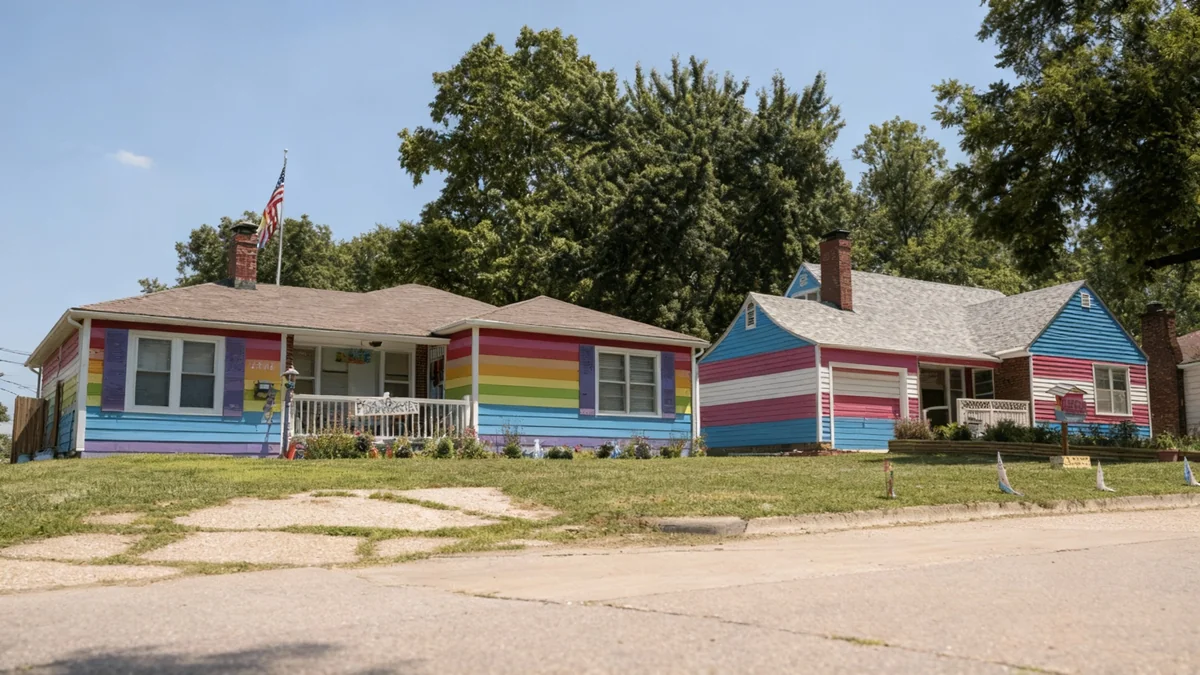Across the United States, homeowners are using their properties to send clear messages, sometimes directly to their neighbors. These structures, often called 'spite houses,' highlight a unique aspect of American property culture where personal grievances can manifest in real estate.
These disputes range from blocking views to expressing strong social statements. The trend reflects a broader American emphasis on individualism and property rights, often leading to highly localized conflicts.
Key Takeaways
- 'Spite houses' are properties built or modified to annoy others.
- This phenomenon is common in the U.S. due to strong private-property culture.
- Examples include homes painted in Pride colors near protest sites.
- Fragmented zoning laws contribute to the ability to create such structures.
- The homes serve as personal symbols and expressions of conflict.
The American Landscape of Property Grudges
The concept of a 'spite house' is not new. These unique structures are specifically designed or altered with the intention of irritating a neighbor or a specific group. This practice thrives in the United States, largely due to its strong private-property culture and decentralized zoning regulations.
Property ownership in America often carries significant personal symbolism. A home represents more than just a dwelling; it signifies independence and personal expression. This deep connection can escalate neighbor-to-neighbor conflicts, turning real estate into a battleground for personal disputes.
Did You Know?
One of the most famous spite houses is Boston's four-story Skinny House. A Civil War soldier reportedly built it to block his brother's harbor view after returning home to find his inheritance diminished.
Notable Examples of Spiteful Architecture
Several well-known examples demonstrate the varied motivations behind spite houses. One notable case involves two properties located directly across the street from the Westboro Baptist Church in Topeka, Kansas. This church is known for its anti-LGBTQ+ rhetoric and for picketing at soldiers' funerals.
The owner of these two homes chose to paint them in the vibrant rainbow colors of the Pride Movement. This act serves as a direct, visible counter-message to the church's protests, transforming the homes into powerful symbols of equality and defiance.
"Your house represents more here than it does in other countries. It's a more personal symbol because it's a homeownership society. There's more neighbor-to-neighbor conflict."
Historical Roots of Property Disputes
Historically, property disputes have often led to creative, albeit hostile, architectural solutions. The Skinny House in Boston is a prime example. Built in 1862, it stands as a narrow, four-story structure, reportedly constructed by a man named Arthur to block his brother's view of the harbor. This act was a direct response to a perceived slight over inherited land.
Such stories highlight how deep-seated personal animosities can find permanent expression in the built environment. These structures are not merely functional; they are statements etched into the landscape.
Broader Context: Hostile Architecture
While 'spite houses' are personal, they fall under the broader category of 'hostile architecture.' This wider term includes urban design elements intended to deter specific behaviors, such as uncomfortable park benches designed to prevent homeless individuals from sleeping on them. However, spite houses are distinct because their hostility is directed at a specific individual or group, often a neighbor.
The Role of Zoning and Individualism
The prevalence of spite houses in the U.S. is deeply connected to the country's fragmented zoning laws. Unlike some other nations with more centralized urban planning, American zoning regulations often vary significantly from one municipality to another. This patchwork of rules can create loopholes or allow for interpretations that enable homeowners to pursue unusual construction projects.
The emphasis on individualism also plays a crucial role. Americans often feel a strong sense of autonomy over their private property. This feeling can empower individuals to make choices about their homes that might be seen as provocative or confrontational by others.
- Private Property Rights: The U.S. places a high value on individual property rights, empowering owners.
- Fragmented Zoning: Inconsistent local zoning laws can create opportunities for unique builds.
- Personal Symbolism: Homes often act as extensions of personal identity and values.
Impact on Urban Design and Community
The existence of spite houses raises questions about urban design and community cohesion. While they are a testament to individual expression, they can also contribute to neighborhood tensions and detract from a sense of shared community space.
Urban planning professor Paavo Monkkonen points out that the U.S. approach to urban design is often not "people-centric." He suggests that some designs prioritize "peace and quiet" for certain residents, sometimes leading to empty public spaces or designs that discourage interaction.
The impact of these structures can extend beyond the immediate neighbors, influencing local property values and the overall aesthetic of a community. They serve as tangible reminders of unresolved conflicts.
The Future of Property Disputes
As urban areas continue to develop and communities become denser, the potential for neighbor-to-neighbor conflicts over property use may increase. The legal frameworks surrounding property rights and zoning will continue to be tested by innovative and sometimes contentious uses of private land.
Understanding the motivations behind spite houses offers insight into the complex interplay between law, personal freedom, and community dynamics in the American context. These properties, while born from discord, ultimately tell a story about the country's unique relationship with homeownership and individual expression.





